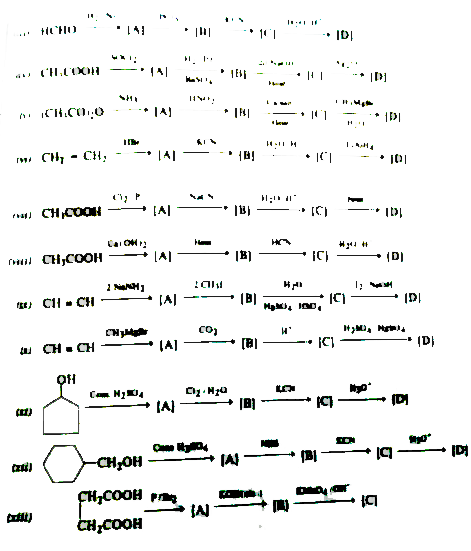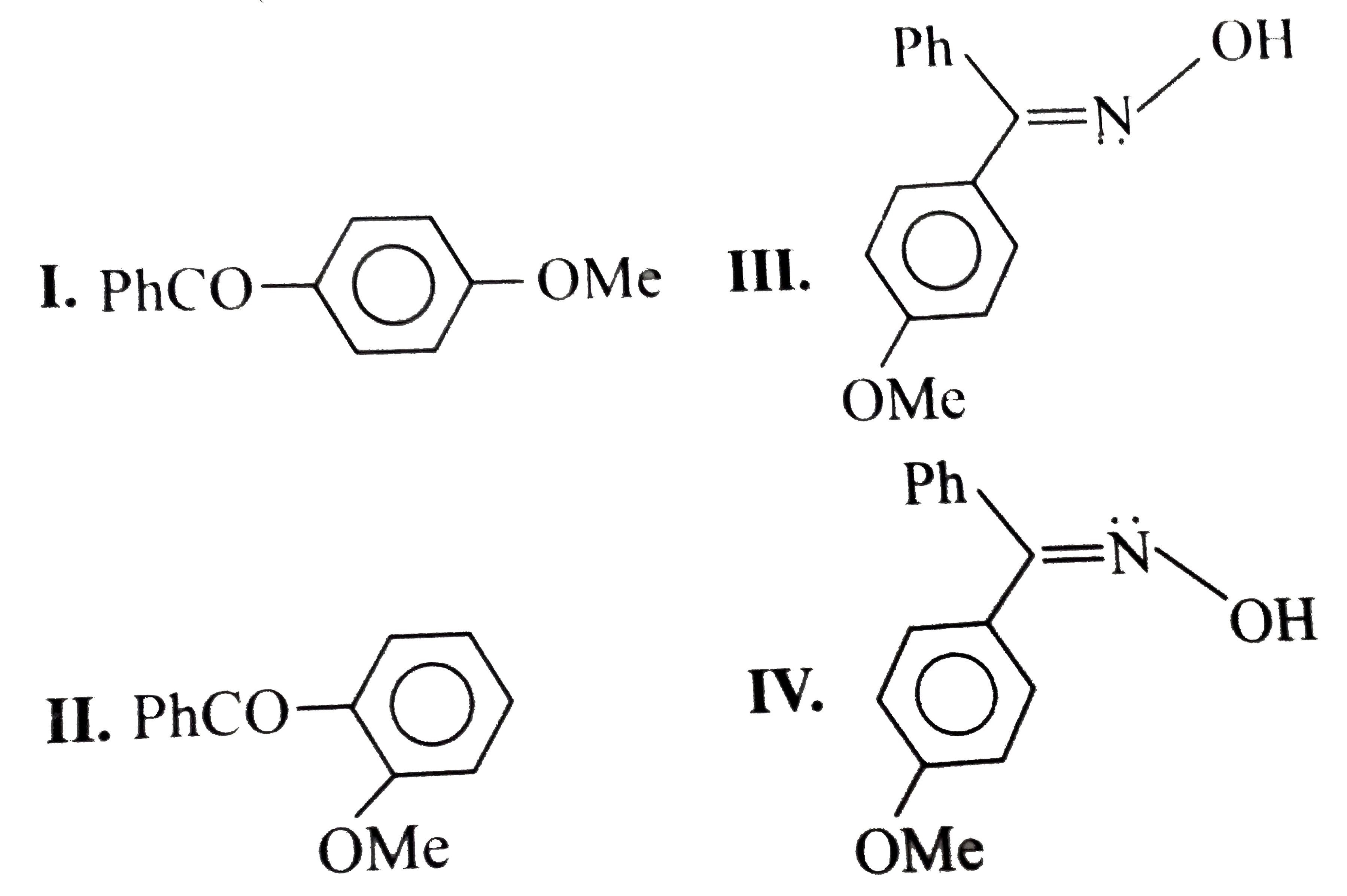IO2←−−BenzaldehydeNH3−−→II, I, II are -
Benzoic acid, Benzaldehyde ammonia
Benzoic acid, Hydrobenzamide
Phenyl acetic , Benzaldehyde ammoina
Benozic acid, Aniline
The correct Answer is:B
To solve the question, we need to analyze the reactions involving benzaldehyde, oxygen, and ammonia. Here’s a step-by-step breakdown of the process:
Step 1: Identify the reaction of benzaldehyde with oxygen.
Benzaldehyde (C₇H₆O) can be oxidized in the presence of oxygen (O₂). The oxidation of benzaldehyde leads to the formation of benzoic acid (C₇H₆O₂).
Hint: Remember that aldehydes are generally oxidized to carboxylic acids.
Step 2: Write the reaction for the oxidation of benzaldehyde.
The balanced reaction for the oxidation of benzaldehyde can be represented as:
Benzaldehyde+O2→Benzoic Acid
Thus, we can conclude that:
- I = Benzoic Acid
Hint: Look for the functional group changes when an aldehyde is oxidized.
Step 3: Identify the reaction of benzaldehyde with ammonia.
When benzaldehyde reacts with ammonia (NH₃), it forms an imine. The reaction involves the nucleophilic attack of the lone pair of electrons from ammonia on the carbonyl carbon of benzaldehyde.
Hint: Recall that imines are formed when aldehydes or ketones react with primary amines.
Step 4: Write the reaction for the formation of the imine.
The reaction can be represented as:
Benzaldehyde+NH3→Hydrobenzamide
In this reaction, the hydroxyl group (OH) is eliminated, leading to the formation of a C=N bond.
Thus, we can conclude that:
- II = Hydrobenzamide
Hint: Consider the stability of the product formed; imines can often polymerize or further react.
Final Conclusion:
Based on the reactions analyzed:
- I = Benzoic Acid
- II = Hydrobenzamide
Summary:
The final answers to the question are:
- I = Benzoic Acid
- II = Hydrobenzamide
Benzaldehyde (C₇H₆O) can be oxidized in the presence of oxygen (O₂). The oxidation of benzaldehyde leads to the formation of benzoic acid (C₇H₆O₂).
The balanced reaction for the oxidation of benzaldehyde can be represented as:
Benzaldehyde+O2→Benzoic Acid
- I = Benzoic Acid
When benzaldehyde reacts with ammonia (NH₃), it forms an imine. The reaction involves the nucleophilic attack of the lone pair of electrons from ammonia on the carbonyl carbon of benzaldehyde.
The reaction can be represented as:
Benzaldehyde+NH3→Hydrobenzamide
In this reaction, the hydroxyl group (OH) is eliminated, leading to the formation of a C=N bond.
- II = Hydrobenzamide
Based on the reactions analyzed:
- I = Benzoic Acid
- II = Hydrobenzamide
The final answers to the question are:
- I = Benzoic Acid
- II = Hydrobenzamide
Topper's Solved these Questions
- ALDEHYDES, KETONES & CARBOXYLIC ACIDSBook:NARAYNAChapter:ALDEHYDES, KETONES & CARBOXYLIC ACIDSExercise:EVALUATE YOURSELF -3
Explore 5 Videos
- ALDEHYDES, KETONES & CARBOXYLIC ACIDSBook:NARAYNAChapter:ALDEHYDES, KETONES & CARBOXYLIC ACIDSExercise:EVALUATE YOURSELF -4
Explore 8 Videos
- ALDEHYDES, KETONES & CARBOXYLIC ACIDSBook:NARAYNAChapter:ALDEHYDES, KETONES & CARBOXYLIC ACIDSExercise:EVALUATE YOURSELF -1
Explore 8 Videos
- ALCOHOLS, ETHERS, PHENOLBook:NARAYNAChapter:ALCOHOLS, ETHERS, PHENOLExercise:Assertion Reaosn
Explore 10 Videos
- AMINES & DIAZO COMPOUNDSBook:NARAYNAChapter:AMINES & DIAZO COMPOUNDSExercise:Subjective type Q.
Explore 13 Videos
Similar Questions
Give structures of A, B and C in the following reactions :
(i) C6H5NO2Sn+HCl−−−−−→ANaNO2+HCl−−−−−−−−−−→273KBH2O−−→C
(ii) CH3CNH2∅H+−−−−→ANH3−−−−−→ΔBBr2+KOH−−−−−−→C
View SolutionGive the structures of A, B and C in the following reactions :
(i) C6H5N+2Cl−CuCN−−−→AH2O/H+−−−−−→BNH3−−−−−→ΔC
(ii) C6H5NO2Sn+HCl−−−−−→ANaNO2+HCl−−−−−−−−−−→273KBH2O/H+−−−−−−−−→ΔC
View Solution
Knowledge Check
ICOcl2←−−−AnilineC2H5MgI−−−−−→II. Products I and II are :
ADiphenylurea , ehtaneBDiphenylurea ,C6H5MgICDipphenlamine , ethaneDDiphenylamine , benzeneThe final product (III) obtained in the reaction sequence.
CH3=O∣∣C−CH2−O∣∣C−OC2H5(i)Na−−−−−−−−−−−−→(ii)C6H5CH2BrIH5O+−−−→IIheat−−−−−−→−CO2III
Product I is :-ACH3−O∣∣C−CH2−C6H5BC6H5−CH2−O∣∣C−OC2H5CC6H5−CH2−CH2−O∣∣C−CH3DCH3−CH2−CH2−O∣∣C−C6H5Which of the following will produce isopropyl amine -
(I) (CH3)2CONH2OH−−−−→XLiAlH4−−−→
(II) CH3−CH2−CHONH3−−→heatXLiAlH4−−−→
(III) (CH3)2CH−OH+PCl5→XNH3−−→
(IV) CH3−CH2−CH2−NH2heat−−→AI, IIBII, IIICI, IIIDIV only
Write the product ? C6H5COOHSOCl2−−−→(A)Pd/BaSO4−−−−−−→(B)(i)HCN−−−−−−−→(ii)H3O⊕C
View Solution(i) CH≡CHH2O−−−−−−−−−→H2SO4/HgSO4[A]o−−→[B]SOCl2−−−→[C]Benzene−−−−→AlCl3[D]
(ii) C2H5ClKCN−−→[A]H2O/H+−−−−−→[B]NH3−−→[C]Heat−−→[D]

View SolutionA sequential reaction may be performed as represented below :
RCH2CO2H−−→(i)RCH2COClNH3−−−−−→(2)
RCH2CONH2(3)−−→
RCO2H(5)←−−RCH2OH(4)←−−RCH2NH2
the appropriate reagent for step (3) is :
View SolutionIn the following sequence of the reactions :
CH3CH2CH2IKOH(Alc.)−−−−−−−→A(i)Br2−−−−−−−−→(ii)alc.KOHBNa/NH3−−−−−→C
The end product C is :
View SolutionKetone (A) NH2OH.HCl−−−−−−−−→ (B) H⊕−−→

The ketone (A) and compound (B), respectively, are:
Ketone (A)
I.
Compound (B)
View Solution
